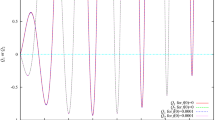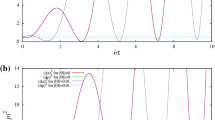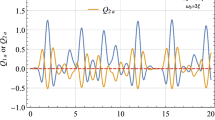Abstract
The Hamiltonian and hence the equations of motion involving the field operators of two quantum anharmonic oscillators coupled through the angular momentum are constructed. The anharmonic terms are such that the conservative nature of the Hamiltonian is retained. The coupled differential equations involving the field operators are nonlinear and are noncommuting as well. The exact closed form analytical solutions of the field operators are certainly a challenging task to address. The numerical solutions for the field operators are also unlikely because of the presence of nonlinearity and the noncommuting nature of the field operators. We provide the solutions of the field operators by using the short time approximation. The solutions are used to investigate the squeezing and the antibunching of photons for composite coherent light interacting with two oscillators coupled through the angular momentum. The second order variances for the canonically conjugate quadrature of both modes are exhibited as a function of dimensionless coupling and anharmonic terms. By considering the phase angles of composite coherent light as zero, we obtain the squeezing in one of the quadrature components \(X_{1}\) at the cost of other quadrature \(P_{1}\) when the frequency of the first oscillator is less than the second one. The squeezing pattern gets reversed when the frequency of the first oscillator is less than the frequency of the second oscillator. The squeezing is increased with the increase of dimensionless coupling time. The monotonic increase of the squeezing with the increase of the dimensionless coupling time is attributed to the shortcomings of short time approximation. However, the dimensionless nonlinear constant causes a decrease in the squeezing effects. The identical behaviour is exhibited for the second mode. The antibunching of photons for both modes is found improbable. Rather, we end up with the bunching of photons for both modes.




Similar content being viewed by others
Data availibility statement
All data generated or analyzed during this study are included in this published article.
References
Basche, T., Moerner, W., Oritt, M., Talon, H.: Photon antibunching in the fluorescence of a single dye molecule trapped in a solid. Phys. Rev. Lett. 69, 1516–1519 (1992)
Bauman, L.E., Klllough, P.M., Cooke, J.M., Vlllarreal, J.R., Laane, J.: Two-dimensional potential energy surface for the ring puckering and ring twisting of cyclopentene-d0, -1-d1, -1,2,3,3–d4, and -d8. J. Phys. Chem. 86, 2000–2006 (1982)
Bose, S.K., Tripathy, D.N.: Studies of coupled anharmonic oscillator problem using coherent states and path integral approaches. Prog. Phys. 31, 131–163 (1983)
Canosa, N., Mandal, S., Rossignoli, R.: Exact dynamics and squeezing in two harmonic modes coupled through angular momentum. J. Phys. B: At. Mol. Opt. Phys. 48, 165501 (2015)
Canosa, N., Rossignoli, R., Garcia, J., Mandal, S., Saha, K.C.: Nonlinear effects on the dynamics of quantum harmonic modes coupled through angular momentum. J. Phys. B: At. Mol. Opt. Phys. 53, 215402 (2020)
Carmichael, H.J., Walls, D.F.: Proposal for the measurement of the resonant Stark effect by photon correlation techniques. J. Phys. B: Atom. Mol. Phys. 9, L43–L46 (1976)
Chew, L.Y., Chung, N.N.: Quantum entanglement and squeezing in coupled harmonic and anharmonic oscillator systems. J. Russ. Laser Res. 32, 331–337 (2011)
Cochrane, P.T., Milburn, G.J., Munro, W.J.: Teleportation using coupled oscillator states. Phys. Rev. A 62, 062307 (2000)
de Gosson, M., Hiley, B.: Short-time quantum propagator and Bohmian trajectories. Phys. Lett. A 377, 3005–3008 (2013)
Diedrich, F., Walther, H.: Nonclassical radiation of a single stored ion. Phys. Rev. Lett. 58, 203–206 (1987)
Estes, L.E., Keil, T.H., Narducci, L.M.: Quantum-mechanical description of two coupled harmonic oscillators. Phys. Rev. 175, 286–299 (1968)
Fan, H.-Y., Lic, C., Jiang, Z.-H.: Spin coherent states as energy eigenstates of two coupled oscillators. Phys. Lett. A 327, 416–424 (2004)
Feldman, A., Kahn, A.H.: Landau diamagnetism from the coherent states of an electron in a uniform magnetic field. Phys. Rev. B 1, 4584–4589 (1970)
Fetter, A.L.: Lowest-Landau-level description of a Bose–Einstein condensate in a rapidly rotating anisotropic trap. Phys. Rev. A 75, 013620 (2007)
Gerry, C.C., Rodrigues, S.: Time evolution of squeezing and antibunching in an optically bistable two-photon medium. Phys. Rev. A 36, 5444–5447 (1987)
Gerry, C.C., Togeas, J.B.: Squeezing and photon antibunching from a two-photon Dicke model. Opt. Commun. 69, 263–266 (1989)
Grangier, P., Roger, G., Aspect, A., Heidmann, A., Reynaud, S.: Observation of photon antibunching in phase-matched multiatom resonance fluorescence. Phys. Rev. Lett. 57, 687–690 (1986)
Granot, E., Marchewka, A.: Short-time quantum dynamics of sharp boundaries potentials. Physica B 459, 62–68 (2015)
Hanbury-Brown, R., Twiss, R.Q.: Correlation between photons in two coherent beams of light. Nature 177, 27–29 (1956)
Hioe, F.T., MacMillen, D., Montroll, E.W.: Quantum theory of anharmonic oscillators: energy levels of a single and a pair of coupled oscillators with quartic coupling. Phys. Rep. 43, 305–335 (1978)
Holzwarth, G., Chabay, I.: Optical activity of vibrational transitions: a coupled oscillator model. J. Chem. Phys. 57, 1632–1635 (1972)
Iafrate, G.J., Croft, M.: Interaction between two coupled oscillators. Phys. Rev. A 12, 1525–1529 (1975)
Ikeda, T., Lord, R.C.: Far-infrared spectra of ring compounds. IX. Far-infrared spectrum and hindered pseudorotation in cyclopentanone. J. Chem. Phys. 56, 4450–4466 (1972)
Jaekel, M.T., Reynaud, S.: Quantum limits in interferometric measurements. Europhys. Lett. 13, 301–306 (1990)
Josephson, B.D.: Possible new effects in superconductive tunnelling. Phys. Lett. 1, 251–253 (1962)
Kodousek, J., Perina, J.: Quantum statistics in parametric generation. Opt. Commun. 50, 411–412 (1984)
Kellman, M.E.: Noninvariance groups for many-particle systems: coupled harmonic oscillators. J. Chem. Phys. 81, 389–396 (1984)
Kimble, H.J., Dagenais, M., Mandel, L.: Photon antibunching in resonance fluorescence. Phys. Rev. Lett. 39, 691–695 (1977)
Lakshmanan, M., Sahadevan, R.: Painlevé property of coupled anharmonic oscillators with N degrees of freedom. Phys. Lett. A 101, 189–194 (1984)
Lehmann, K.: Harmonically coupled, anharmonic oscillator model for the bending modes of acetylene. J. Chem. Phys. 96, 8117–8119 (1992)
Loudon, R.: The Quantum Theory of Light. OUP Oxford (2000)
Loudon, R., Knight, P.L.: Squeezed Light. J. Mod. Opt. 34, 709–759 (1987)
Louisell, W.H.: Quantum Statistical Properties of Radiation. Wiley Classic Library Edition, New York, p. 205 (1990)
Madhav, A.V., Chakraborty, T.: Electronic properties of anisotropic quantum dots in a magnetic field. Phys. Rev. B 49, 8163–8168 (1994)
Mandal, S.: Squeezing, higher-order squeezing, photon-bunching and photon-antibunching in a quadratic Hamiltonian. Mod. Phys. Lett. B 16, 963–973 (2002)
Mandal, S.: Photon-bunching, photon-antibunching and the nonclassical photon statistics of coherent light coupled to a driven harmonic oscillator of time dependent mass and frequency. Opt. Commun. 240, 363–378 (2004)
Mandal, S., Perina, J.: Approximate quantum statistical properties of a nonlinear optical coupler. Phys. Lett. A 328, 144–156 (2004)
Mandal, S., Perina, J.: Approximate quantum statistical properties of a nonlinear optical coupler. Phys. Lett. A 328, 144–156 (2004)
Mandal, S., Saha, K.C., Bayen, D.K., Canosa, N., Rossignoli, R.: An exact algebraic solution of two harmonic modes coupled through the angular momentum. Appl. Phys. B: Laser Opt. 129, 75 (2023)
Mielke, S.L., Foster, G.T., Orozco, L.A.: Nonclassical intensity correlations in cavity QED. Phys. Rev. Lett. 80, 3948–3951 (1998)
Mollow, B.R.: Quantum statistics of coupled oscillator systems. Phys. Rev. 162, 1256–1273 (1967)
Neito, M.M.: Mounting evidence for the existence of a neutral vector Boson. Phys. Rev. Lett. 21, 488–490 (1968)
Ng, K.M., Lo, C.F.: Coherent-state propagator of two coupled generalized time-dependent parametric oscillators. Phys. Lett. A 230, 144–152 (1997)
Oktel, M.O.: Vortex lattice of a Bose–Einstein condensate in a rotating anisotropic trap. Phys. Rev. A 69, 023618 (2004)
Orany, F.A.A., Abdalla, M.S., Perina, J.: Quantum properties of the parametric amplifier with and without pumping field fluctuations. Opt. Commun. 187, 199–209 (2001)
Pathak, A., Mandal, S.: Photon-bunching, photon-antibunching and nonclassical photon statistics of coherent light coupled to a cubic nonlinear medium. Mod. Phys. Lett. B 17, 225–233 (2003)
Pathak, A., Krepelka, J., Perina, J.: Nonclassicality in Raman scattering: Quantum entanglement, squeezing of vacuum fluctuations, sub-shot noise and joint photon-phonon number and integrated-intensity distributions. Phys. Lett. A 377, 2692–2701 (2013)
Perina Jr. J., Perina, J.: Progress in Optics, Vol. 41, Ed: E. Wolf. Elsevier, pp. 361–419 (2000)
Rebon, L., Rossignoli, R.: Entanglement of two harmonic modes coupled by angular momentum. Phys. Rev. A 84, 052320 (2011)
Rebon, L., Canosa, N., Rossignoli, R.: Dynamics of entanglement between two harmonic modes in stable and unstable regimes. Phys. Rev. A 89, 042312 (2014)
Rempe, G., Thompson, R.J., Brecha, R.J., Lee, W.D., Kimble, H.J.: Optical bistability and photon statistics in cavity quantum electrodynamics. Phys. Rev. Lett. 67, 1727–1730 (1991)
Ring, P., Schuck, P.: The Nuclear Many Body Problem. Springer, New York (1980)
Sen, B., Mandal, S.: Squeezed states in spontaneous Raman and in stimulated Raman processes. J. Mod. Opt. 52, 1789–1807 (2005)
Short, R., Mandel, L.: Observation of sub-Poissonian photon statistics. Phys. Rev. Lett. 51, 384–387 (1983)
Smithson, T.L., Duckett, J.A., Paul, R., Wieser, H., Birss, F.W.: A comparison of computational and model approaches to the two-coupled anharmonic oscillator problem in five-membered ring compounds. Mol. Phys.: Int. J. Interface Between Chem. Phys. 53, 1495–1516 (1984)
Stoler, D.: Photon antibunching and possible ways to observe it. Phys. Rev. Lett. 33, 1397–1400 (1974)
Walls, D.F.: Evidence for the quantum nature of light. Nature 280, 451–454 (1979)
Walls, D.F.: Squeezed states of light. Nature 306, 141–146 (1983)
Walls, D.F., Milburn, G.J.: Quantum Optics, p. 77. Springer Verlag, Berlin (1994)
Acknowledgements
The authors are thankful to Professor R. Rossignoli and Professor N. Canosa of University of La Plata for discussions and suggestions. One of the authors SM thanks the The World Academy of Sciences (TWAS), Trieste, Italy and the Consejo Nacional de Investigaciones Científicas y Técnicas, Argentina for financial support through TWAS-UNESCO associateship programme.
Funding
The financial support from the TWAS in terms of the associateship programme is acknowledged.
Author information
Authors and Affiliations
Contributions
DKB performed the numerical estimates. The draft copy and the plan was prepared by KCS. SM wrote the paper and the entire analytical calculation.
Corresponding author
Ethics declarations
Ethical approval
Not applicable for this article.
Conflict of interest
The authors declare that they have no known competing financial interests or personal relationships that could have appeared to influence the work reported in this paper. The authors declare the following financial interests/personal relationships which may be considered as potential competing interests. The authors do not have any competing interests.
Additional information
Publisher's Note
Springer Nature remains neutral with regard to jurisdictional claims in published maps and institutional affiliations.
Appendices
Appendix I
In the present appendix, we give the detailed calculation for getting the expressions of the second order variances of the second field mode. The canonically quadrature operators for the second mode follow as
where the equations (14), and (16) are used. Now, we express the equations (19) in the following convenient form
where the parameters are given by
Under the realm of short time approximation (i.e up to the second orders in time t), we calculate the following relevant parameters for the subsequent development.
where the equations (21) are used. Now, we calculate the second order variances of the quadrature operators \(X_{2}\) and \(P_{2}\) in terms of the initial coherent state. Hence, we have
Now, by using the equations (21)-(35), we give the explicit expressions for the second order variances involving the quadrature operators \(\Delta X_{2}^{2}\) and \(\Delta P_{2}^{2}.\) These are
Appendix II
The number operator for the first mode follows as
After simplification, we obtain the analytical expression of the number operator \(n_{1}(t)\)
The average photon number of the first field mode is now calculated in terms of the initial coherent state. The corresponding average photon number \({\bar{n}}_{1}(t)=\langle a_{1}^{\dagger }a_{1}\rangle\) is given by
where the equations (17) and (67) are used. Now, the second order variance of \(n_{1}(t)\) is calculated in terms of the initial coherent state and is given by
Now, for second mode, the number operators follows as
Hence, the average photon number in the second mode is readily available through the initial composite coherent state and is given by
Now, the second order variances of \(n_{2}(t)\) are calculated in terms of the initial coherent state and are given by
For the second mode, the analytical expressions for the average photon number and its second order variance are now available through the equations (70) and (71) respectively.
Rights and permissions
Springer Nature or its licensor (e.g. a society or other partner) holds exclusive rights to this article under a publishing agreement with the author(s) or other rightsholder(s); author self-archiving of the accepted manuscript version of this article is solely governed by the terms of such publishing agreement and applicable law.
About this article
Cite this article
Bayen, D.K., Saha, K.C. & Mandal, S. Squeezing and bunching of photons of coherent light interacting with two quantum anharmonic oscillators coupled through the angular momentum. Opt Quant Electron 56, 832 (2024). https://doi.org/10.1007/s11082-024-06561-x
Received:
Accepted:
Published:
DOI: https://doi.org/10.1007/s11082-024-06561-x




